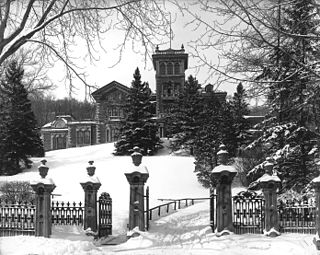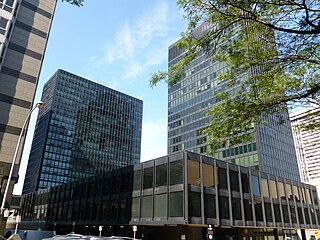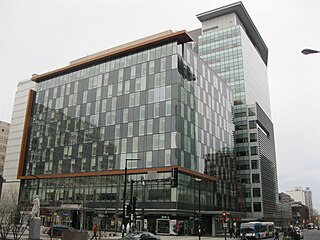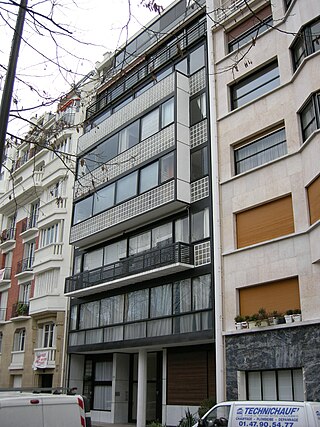
Guy–Concordia station is a Montreal Metro station in the borough of Ville-Marie in Montreal, Quebec, Canada. It is operated by the Société de transport de Montréal (STM) and serves the Green Line. The station opened on October 14, 1966, as part of the original network of the Metro. It has consistently been one of the network's busiest stations, ranking 5th from 2000 to 2001, 4th from 2002 to 2007, 3rd since 2008, and 2nd since 2021.

The Golden Square Mile, also known as the Square Mile, is the nostalgic name given to an urban neighbourhood developed principally between 1850 and 1930 at the foot of Mount Royal, in the west-central section of downtown Montreal in Quebec, Canada. The name 'Square Mile' has been used to refer to the area since the 1930s; prior to that, the neighbourhood was known as 'New Town' or 'Uptown'. The addition of 'Golden' was coined by Montreal journalist Charlie Lazarus, and the name has connections to contemporary real estate developments, as the historical delimitations of the Golden Square Mile overlap with Montreal's contemporary central business district.

Ville-Marie is the name of a borough (arrondissement) in the centre of Montreal, Quebec. The borough is named after Fort Ville-Marie, the French settlement that would later become Montreal, which was located within the present-day borough. Old Montreal is a National Historic Site of Canada.

Westmount Square is a residential and office complex located in Westmount, Quebec, Canada. There are two residential apartment buildings and two office buildings. These towers sit atop an underground shopping centre consisting of thirty-five shops. It is located between Sainte Catherine Street and De Maisonneuve Boulevard and between Wood Avenue and Greene Avenue. It is connected to Place Alexis Nihon, Dawson College, and the Atwater Metro station by a tunnel.

Downtown Montreal is the central business district of Montreal, Quebec, Canada.

The Alwyn Court, also known as the Alwyn, is an apartment building at 180 West 58th Street, at the southeast corner with Seventh Avenue, in the Midtown Manhattan neighborhood of New York City, United States. The Alwyn Court was built between 1907 and 1909 and was designed by Harde & Short in the French Renaissance style. It is one of several luxury developments constructed along Seventh Avenue during the late 19th and early 20th century.

Sherbrooke Street is a major east–west artery and at 31.3 kilometres (19.4 mi) in length, is the second longest street on the Island of Montreal, Canada. The street begins in the town of Montreal West and ends on the extreme tip of the island in Pointe-aux-Trembles, intersecting Gouin Boulevard and joining up with Notre-Dame Street. East of Cavendish Boulevard this road is part of Quebec Route 138.

Bishop Street is a north–south street located in downtown Montreal, Quebec, Canada. With a total length of 0.6 km, it links Sherbrooke Street in the north to René Lévesque Boulevard in the south. Like neighbouring Crescent Street, Bishop is home to many pubs, bars, clubs and restaurants.

De Maisonneuve Boulevard is a major westbound boulevard located in downtown Montreal, Quebec, Canada. It is named after the founder of Montreal, Paul Chomedey de Maisonneuve. It is a one-way street westbound.

Shaughnessy Village is a neighbourhood of Montreal, Quebec, Canada, located on the western side of the Ville-Marie borough. It is bounded by Guy Street to the east, Atwater Street to the west, Sherbrooke Street to the north, and René Lévesque Boulevard and the Ville-Marie Expressway to the south.

Quartier Concordia is a neighbourhood redevelopment project centred on Concordia University's Sir George Williams campus in downtown Montreal, Quebec, Canada. Bordered by Sherbrooke Street, Saint-Mathieu Street, René Lévesque Boulevard and Bishop Street, the district is designed to be a green urban campus that will improve the use and quality of public places and spaces, student life on campus and transportation.

The Palmer Park Boulevard Apartments District is a collection of three apartment buildings located in Highland Park, Michigan. The district was listed on the National Register of Historic Places in 1992.
René G. Lépine was a Canadian real estate developer and philanthropist. Lépine was the chairman of Groupe Lépine, a real estate development and investment firm he founded in 1953. He is widely considered one of the most influential French Canadian real estate developers of his time. His companies developed over $5 billion of real estate in Canada and the United States since the 1960s. He also owned a portfolio of multifamily and retail properties in Montreal and Ottawa. Lépine developed many buildings considered landmarks in Montreal, including the Olympic Village and Le Sanctuaire du Mont-Royal. Lépine is also credited with having developed the first condominiums in Montreal in 1981.

Concordia University Library is the library system at Concordia University in Montreal, Quebec, Canada. Concordia University has three library locations. The R. Howard Webster Library is located in the J.W. McConnell Building on the Sir George Williams Campus and the Georges P. Vanier Library is located on the Loyola Campus. On September 2, 2014, the Library opened the Grey Nuns Reading Room, a silent study space for Concordia students located in the former Chapel of the Invention of the Holy Cross. The Reading Room has seating for 192 students, with an additional 42 chairs in small reading rooms. A Political Science student was the first to enter.

The J.W. McConnell Building is an academic building on the Sir George Williams campus of Concordia University in Montreal, Quebec. Built in 1992, it is named for John Wilson McConnell, a Canadian businessman and philanthropist whose foundation contributed to the building's erection. It sits between Bishop Street and Mackay Street on De Maisonneuve Boulevard in the Quartier Concordia. It is the home of the R. Howard Webster Library, the Departments of Education, English, Études Français, History, and Mathematics & Statistics. It is also home to the Leonard and Bina Ellen Art Gallery, the J.A. DeSève Cinema, the Birks Student Centre and Welcome Centre, as well as many other services such as the Campus Bookstore and Print Services.

Le V is a hotel and apartment complex in Montreal, Quebec, Canada. It is located on René Lévesque Boulevard West between Bleury Street and Anderson Street in Downtown Montreal.

The Henry F. Hall Building is a building on the Sir George Williams Campus of Concordia University in Montreal, Quebec, Canada. Referred to as the 'H' building, it is located at 1455 de Maisonneuve Boulevard West, in between Mackay Street and Bishop Street in the Quartier Concordia neighbourhood.
The historical villas of Monaco represent a significant example of residential architecture. Originally seen as symbols of Belle Epoque luxury, they were once emblematic of the Principality itself. However, by the 1950s they were viewed by Monaco's Consultative Committee on Public Works as a social anachronism. While recent years have seen a renewed appreciation within the Principality for villa architecture, the number of historic villas remaining declines each year. In 1954 the Principality possessed 688 villas; only a small fraction of that number still survive.

Maxwell Myron Kalman was a Canadian architect, real estate developer, and philanthropist. He designed over 1,100 commercial, residential, and institutional projects in Quebec before and after World War II. He was noted as the architect of Canada's first shopping centre, the Norgate shopping centre, which opened in Montreal, Quebec in 1949.

Immeuble Molitor is an apartment building designed by Le Corbusier and Pierre Jeanneret and built between 1931 and 1934. Located at the border between the city of Paris and the commune of Boulogne-Billancourt in France, it has been listed along with 16 other architectural works by Le Corbusier as a UNESCO World Heritage Site. Le Corbusier lived in the building from its completion until his death in 1965.



















